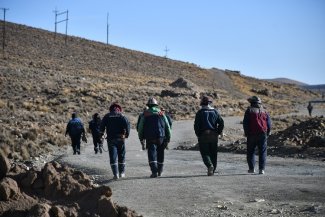In this image from September 2016, a NASA rocket takes off with the Osiris-Rex probe from Cape Canaveral in Florida, heading for asteroid Bennu (320 million kilometres from Earth). After collecting samples from the asteroid’s surface and spending time in orbit, it has begun its return to Earth, and is scheduled to arrive in 2023.
A source of poetic musings for some and an area of geostrategic competition for others, space is also starting to become a new niche market for the shrewdest of public and private entrepreneurs. For decades, the conquest of space was essentially just one more area of strategic competition between the great powers but now, the most intrepid economic players are beginning to see it as an opportunity to make handsome profits from everything that happens above an altitude of 100 kilometres – the frontier that marks the start of outer space. Rapid technological progress and human need (but also the urge to push boundaries and the pull of exhibitionism and fame) have brought us to a point where space mining and space tourism have already moved beyond the realms of science fiction and into the realms of the possible, becoming real options in the here and now.
With regard to space mining, there is the recent news that NASA’s Osiris-Rex probe has begun its journey home with material collected from the surface of asteroid Bennu (with the aim of studying the early solar system). It is not the first, as the Japanese probe Hayabusa reached the vicinity of asteroid Itokawa in September 2005 but, if it does make it back to Earth (in September 2023), it will be the most important mission in this field, demonstrating the technical possibility of landing on an asteroid, despite the lack of gravity, and bringing home resources.
These resources, that is, “the mineral wealth resident in the belt of asteroids between the orbits of Mars and Jupiter” are estimated, according to NASA, to be worth “equivalent to about US$100 billion for every person on Earth today”. Then there are the thousands of asteroids located between Mars and Earth, with some 12,000 passing relatively close to our planet every year (identified as NEA – Near Earth Asteroids) and, of course, the Moon.
From a strictly economic perspective, the accumulated potential is dazzling, be it on the Moon (the first target in sight) or on carbonaceous (C-type), metallic (M-type) and siliceous (S-type) asteroids. It is first and foremost about accessing water, which is vital for missions to other planets, for human consumption and as a basic input for generating energy for any bases that might be set up out there, and as fuel for interplanetary spacecrafts. But the estimates regarding the existence of rare earths and commodities such as iron, nickel, platinum, gold, iridium, palladium, magnesium, rhodium, osmium and ruthenium are astounding.
Beyond the technical difficulties to be overcome before we can envisage any profitable exploitation of these vast resources, this hypothetical future raises a multitude of legal and ethical concerns.
To begin with, all we have at our disposal is an imperfect Outer Space Treaty (1967), which establishes that no nation can claim ownership of any celestial body but does not specify whether the same applies to the resources on them. The same issue has also been left unresolved in the Artemis Accords, signed on 13 October 2020 by eight countries (Australia, Canada, Italy, Japan, Luxembourg, the United Arab Emirates, the United Kingdom, and the United States) to regulate the exploitation of the Moon, although they do recognise property rights for those who operate on our natural satellite and establish safety zones around any future bases that may be established there.
Other issues to consider are whether, for example, the Moon is a legal person or not, and whether its future exploitation represents a new form of colonisation. In any case, no paradigm shift can take place until it is possible to produce the fuel needed on those bodies to make such long journeys with such valuable materials.
Irreversible public-private confluence
At a time when international tourism is still a long way from regaining the intensity of the pre-coronavirus pandemic era, there are those who are already planning to take advantage of the adventurous zeal of a few privileged individuals to make money. The first step was not in fact taken by a forward-looking private company, but by Russia, which, in April 2001, whilst in dire financial straits, decided to offer the third seat of its Soyuz spacecraft, bound for the International Space Station (ISS), to a US citizen, Dennis Tito, in exchange for US$20 million.
The initial US reluctance towards allowing this type of activity did not manage to prevent the door being opened to similar flights, offering the same opportunity to seven other extremely wealthy individuals (the last in 2009). And it has not taken long for private companies to climb aboard. This type of space tourism to the ISS is set to resume in 2023. In the meantime, private suborbital flights have come a long way since Mojave Aerospace Ventures took its suborbital spacecraft, SpaceShipOne, to an altitude of 103 kilometres in 2004. Since then, there has been a flurry of projects aimed at solving the technical problems of such a journey and substantially lowering the costs.
In times of forced austerity, this is also what seems to have attracted state agencies to the idea of having private entrepreneurs, such as SpaceX, Blue Origin and Virgin Galactic, with whom to share the risks and costs of their own national projects. These businesses, in the meantime, are already competing with each other to gain an advantage in the private market. Everything seems to point to the fact that this public-private confluence is here to stay when it comes, for example, to taking astronauts or material to the ISS, the Moon or beyond. In May last year, NASA astronauts reached the ISS aboard the Crew Dragon spacecraft of SpaceX, the same company that is soon to take them to the Moon with its Starship spacecraft. These same spacecrafts will soon take private individuals to the ISS and the Moon.
This cooperation between states and private companies is being replicated to respond to the growing needs arising from the boundless technological advances in the fields of telecommunications, artificial intelligence and 6G, with increasingly sophisticated satellite services.
To get an idea of the commercial potential of providing high-speed, low-latency and low-cost internet in rural areas and developing countries, look at the task being undertaken by Elon Musk, for example, through his company Starlink (a subsidiary of SpaceX). By the end of this year, the company expects to have achieved complete coverage, having conducted a total of 28 satellite launches since 2018 (with an average of 60 satellites per launch), and hopes to have a constellation of around 42,000 satellites by the end of 2027, in orbit at an altitude of 550 kilometres. Other projects such as Britain’s OneWeb, Amazon’s Project Kuiper or China’s Starnet are already looming in the background.
Despite the many obstacles to be overcome and doubts to be cleared up, none of them seem to be enough to dampen the eagerness of those who are already looking towards the stars with greedy eyes, with US entrepreneurs making the biggest strides in this direction. And although more questions than answers remain as to how to realise so many business dreams, the number of announcements about ever more bizarre projects continues to multiply, such as the Gateway Foundation’s project to build a hotel in Earth’s orbit, or the Orbital Assembly Corporation’s Voyager Station project, consisting of 24 modules assembled to form a kind of rotating wheel in which to accommodate those who overcome their fear of the risks inherent to this type of adventure and have sufficient financial resources to indulge themselves. Roll up, roll up, ladies and gentlemen!











